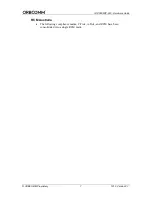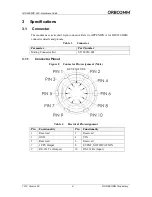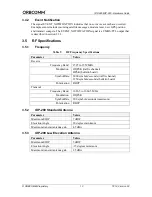
IDP-280/IDP-290 - Hardware Guide
T212, Version 03 12 © ORBCOMM Proprietary
3.4
Serial Interfaces
3.4.1
RS-232
The RS-232 interface defaults to the following settings: 9600 bps, 1 start, 8 data, no
parity and 1 stop bit, and operates in auto-power down mode. The baud rate is
configurable up to 115,200 bps.
The modem remains awake with its internal RS-232 transceiver active whenever the RS-
232 Rx line senses a valid RS-232 input voltage level. To allow the unit to power down
the serial interface and go to sleep, the RS-232 Rx line must be unpowered (hardware
connected to the RS-232 Rx pin must be disconnected or the RS-232 transceiver must be
powered off so that no voltage is applied to this pin).
The electrical characteristics of the interface are:
Parameter
Minimum
Typical
Maximum
Units
Serial Rx Input Low Threshold
0.6
-
-
V
Serial Rx Input High Threshold
-
-
2.4
V
Serial Tx Low Output
(3 k
load)
-
-
-3.7
V
Serial Tx High Output
(3 k
load)
3.7
-
-
V
3.4.1.1
Auto RS-232 Power On/Off
The modem uses the input voltage to turn the RS-232 driver on/off when auto RS-232
mode is selected.
Table 8
Auto RS-232 Power On/Off
Parameter
Value
Valid Rx Input Threshold
Rx > 2.7 V or Rx < -2.7 V
Invalid Rx
-0.3 V < Rx < 0.3 V
3.4.1.2
Force the RS-232 Driver On
If the device connecting to the IDP-280 operates in auto-shutdown mode, the IDP-280's
serial interface can be activated by using an external pull-up resistor on the RS-232 Rx
line to generate a minimum of 2.7 V.
The recommended external resistor values below assume a 3k input worst case resistance,
a minimum input power voltage of 10V for a 12 V system and 20V for a 24V system.
For a 12 V system, a 7.5k pull-up ensures 2.9 V at the Rx input
For a 24 V system, an 18k pull-up yields 2.9 V at the Rx input
Note:
With an external pull-up, IDP-280's RS-232 drivers are on continuously which
prevents the modem from entering its lowest power modes.
















































